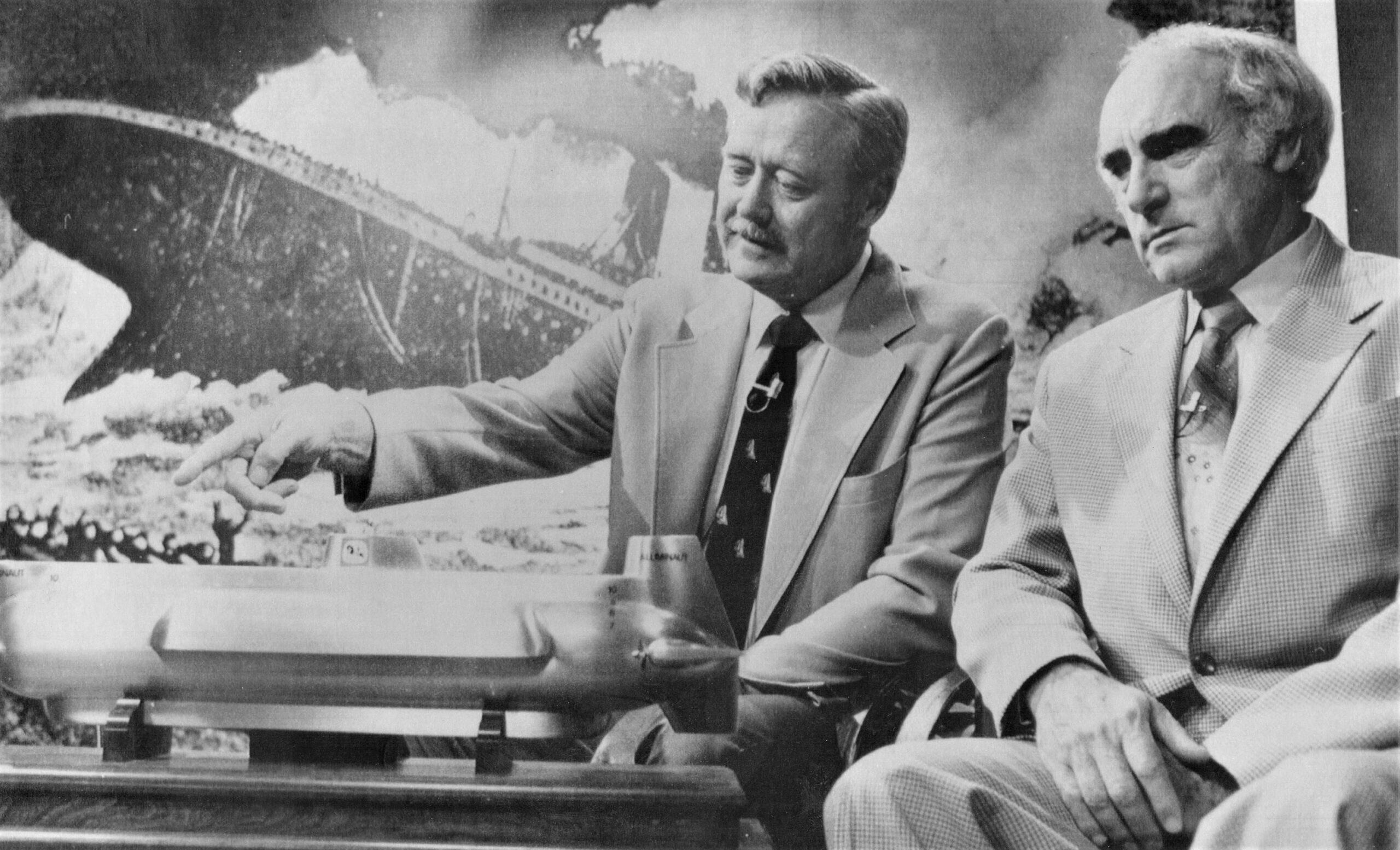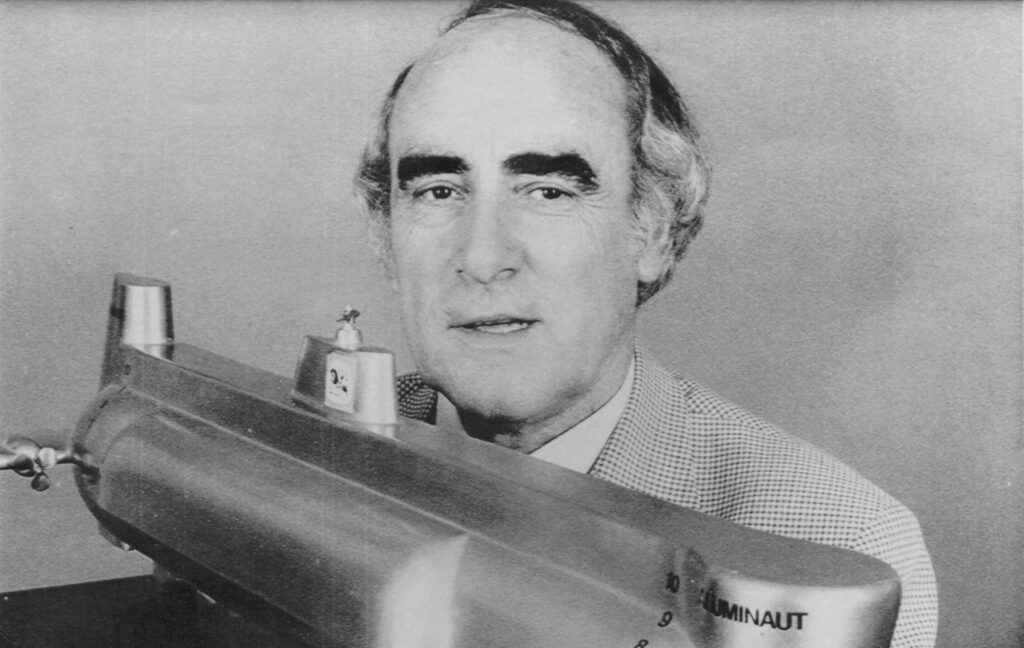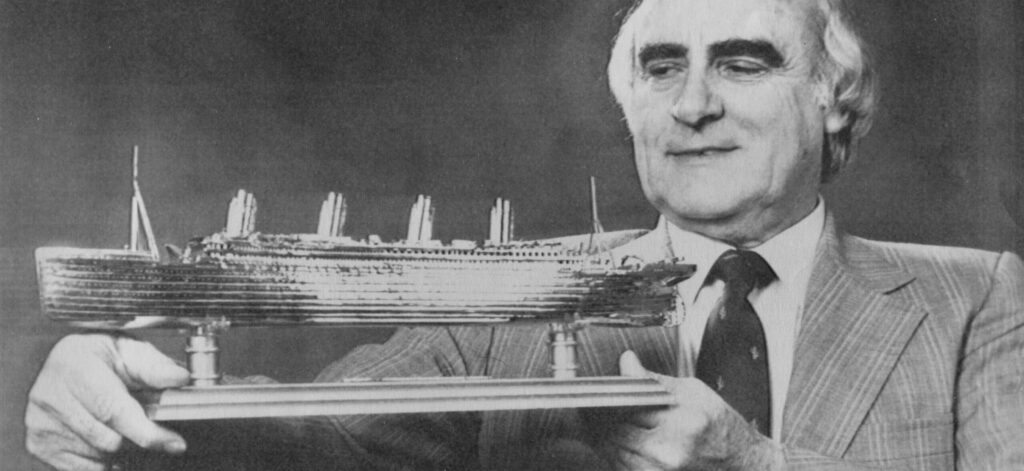JACK GRIMM 1980,1981 & 1983

While many small operations were conducted to locate Titanic none perhaps was more prominent than those conducted by Texas oil tycoon Jack ‘Cadillac’ Grimm, who conducted 3 major expeditions to locate the wreck of Titanic in 1980, 1981, and in 1983. Jack Grimm was perhaps the most colorful and eccentric of characters to seek the lost liner. A self-made billionaire, he’d already financed expeditions to locate Noah’s Ark, the Loch Ness Monster, Bigfoot, and even conduct a search for the hollow earth, so it came as no surprise to the world when he announced his aim to seek out and discover the legendary ship. A massive fundraising campaign went out amongst Grimm and his associates which saw a book deal, song label, a documentary to be narrated by legendary orator Orson Welles, and still more funds over some very well played hands at poker. On the 17th of July, 1980, Grimm departed for the North Atlantic aboard the research vessel H.J.W. Fay.
Onboard was a dazzling array of deep water sonar and underwater detection gear and a contracted crew of professionals to operate it , most of which was acquired from the Lamont–Doherty Geological Observatory and Columbia University thanks to a rather sizable donation made by Grimm.
Among the many scientific minds aboard this initial expedition was Drs. William B. Ryan of Columbia University and Fred Spiess of Scripps Institution of Oceanography in California joined the expedition as consultants and provided an expert opinion on all data collected during their search. According to Titanic lore, it seems that ‘Cadillac Jack’ being ever-true to form at one point brought a trained monkey aboard and introduced it to the crew. The monkey, whose name was “Titan” was trained to point to a spot on the map where Titanic supposedly lay, and as the story goes the scientists gave Grimm a flat “It’s either the monkey or us” and the scientists prevailed as Grimm grumbled about preferring the monkey. Truth truly is stranger than fiction.
The first expedition departed Port Everglades, Florida, with much hype and fanfare. The world held its breath, and it would hold it for some time to come. The expedition, which lasted 3 weeks’ time between the months of July and August failed to find the Titanic. A combination of faulty equipment, most of which was largely untested prior to use, and a steady stream of bad weather is what ultimately doomed this first attempt. However, the expedition did achieve much in terms of ground covered. The MARC sonar system, though it was relatively ancient by today’s standards, did manage to scan approximately 500 square miles of the ocean floor and identify 14 possible targets of interest which might have been Titanic. Sadly, due to heavy seas, a tail fin was ripped off which destroyed the onboard magnetometer. This device has one purpose, and one purpose only… to detect the presence of METAL on the ocean floor. The expedition concluded with an undersea map of targets with no idea which ones were man-made or natural.


Not to be deterred, Grimm would return to the North Atlantic in June of 1981 in a second expedition aboard the research vessel Gyre, with scientists Spiess and Ryan again joining the expedition. Armed with a better array of equipment and a much more up-to-date sonar system, the Scripps Deep Tow, the team felt confident in their ability to locate Titanic. Once again, the North Atlantic seemed determined not to give up Titanic. Bad weather and equipment malfunction again hampered the expedition, and yet the effort continued on. Reports are mixed on the final results from this expedition, with some sources claiming that 13 of the 14 targets were covered and found to be natural, while others report that all 14 targets were not man-made. However, it was on this expedition that a strange shape was spotted on the ocean floor. The shape, laying not far from one of the target zones, appeared to be the blade from a propeller. The strange-looking object was spotted on the last day of the expedition and an enthusiastic Grimm announced upon his return that TITANIC or at least a PIECE of it had indeed been found. The scientists were at odds with Grimm over the results of this discovery and in the year that followed Grimm would continue to push his discovery of the blade as proof that the Titanic did indeed lay very close to his last possible target.
It is worth noting that for all his eccentricities, and the blind faith he had in the results of these expeditions that in the end Jack Grimm was VERY close to the Titanic’s resting place. According to an overview of his data and compared with what we know today about the location of the wreck, we know that his broken sonar unit DID pass almost directly over the wreck of Titanic stern, but failed to pick it up since it was not yet at the right depth, and without a proper magnetometer at work it would have been impossible for him to know what was down below. In a similar twist of fate, on his second expedition, the “Deep Tow” also passed within 1.5 miles (2.4km) of the Titanic’s stern section yet again. And what of “Grimms Propeller”? As it became known to the press? The blade, or whatever it was, was never seen again so far as we can tell, however, it is worth noting that several survivors on Titanic described vibrations following the collision, and one even believed the ship had indeed thrown a propeller blade. The starboard propeller on the wreck, though partly buried in the sediment, does seem to be missing a blade… The case remains unsolved, and the issue is a hotly debated one. However, one thing that is beyond debate, and (as Grimm put it) ‘Beyond Reach’ is just how tragically close he came on both of those fateful expeditions.
Jack Grimm made his third and final attempt to locate Titanic with Dr. William B. Ryan of Columbia University aboard the research vessel Robert D. Conrad. Grimm had set a course directly for the site of the ‘blade’ and was going to attempt a magnetometer and sonar sweep of the region around it. Once again, the North Atlantic stepped in and severe weather prompted the expedition to be brought to an early halt with nothing being found or accomplished.
The final resting place of the Titanic would remain a mystery for another 2 years.

